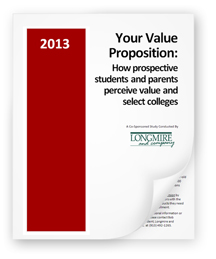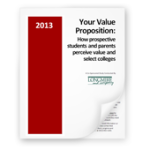“We need more enrollments,” says the college president or chief financial officer or take your pick. No problem, you may be thinking, in light of the fact that tuition has been raised – again – and there are areas of the institution that are in need of let’s say “enhancement in quality.” What’s an enrollment manager to do? Information from our recent national study provides the answer.
 The perceived value that a student attaches to your institution correlates strongly with his or her likelihood of enrollment. Perceived value has three components: perceived quality, cost and excitement about attending. A change in any one will impact your total perceived value score which, in turn, impacts enrollment.
The perceived value that a student attaches to your institution correlates strongly with his or her likelihood of enrollment. Perceived value has three components: perceived quality, cost and excitement about attending. A change in any one will impact your total perceived value score which, in turn, impacts enrollment.
The perceived quality of a college may be more or less important from student to student although it may be safely assumed that it is universally important. Cost is also important. These two factors, however, do not have as strong an influence on enrollment as does the student’s excitement about attending the college. Students may find colleges of higher perceived quality and lower cost than others under consideration but if their level of excitement about attending is low then they are significantly less likely to enroll.
Of the three components, cost is likely to be the hardest for a college to change. Its published sticker price may be flexible through discounting but in all likelihood tuition will continue to rise.
Real and perceived qualities are changeable. However, both take time, require internal collaboration, and demand adequate resources.
The single component in the value score that is most flexible and impacting on enrollment growth is student excitement about attending. It is more strongly correlated to enrollment – by a factor of two – than either cost or perceived quality. This was one of several surprising findings revealed in Longmire and Company’s latest nationally co-sponsored study, “Your Value Proposition: How prospective students and parents perceive and select colleges.” Click here to download a copy of the report.
Generating excitement is a multi-dimensional process and should involve everyone on campus. It may entail building and communicating a brand that attracts individuals with similar interests, putting students in the company of others with similar passions, providing opportunities to work closely with faculty, offering prompt and attentive customer service, having a unique energy and atmosphere on campus, and any number of other attributes that strike an emotional chord with a student and parent.
Creating excitement is in the wheelhouse (or should be) of the admission office and admission counselors. However, many people working in admissions don’t know how to create the level of excitement that it takes to win an emotional commitment from the student that will lead to enrollment. This problem usually arises because the department or counselor spends too much time selling the institution rather than trying to understand what the student sees and feels as being valuable.
The answer to increasing enrollment in the face of tuition and quality challenges lies in taking an entirely student-centric approach to recruiting where the admission office and counselors realize that “it’s not about the institution – it’s about the student.” This is powerful when put into practice. Through our Interactive Training Workshops for counselors, we spend a great deal of time changing the focus of admission counselors. We see their transformation and improvements in productivity. Most importantly, we see changes in the recruiting process that exposes students to the information and experiences that truly interest and excite them.

 To download “The Value Proposition” report or copies of our previous national co-sponsored studies,
To download “The Value Proposition” report or copies of our previous national co-sponsored studies, 
